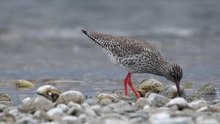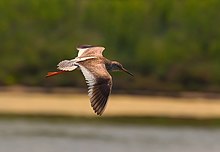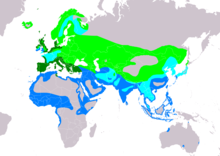Redshank
| Redshank | ||||||||
|---|---|---|---|---|---|---|---|---|

Redshank ( Tringa totanus ) |
||||||||
| Systematics | ||||||||
|
||||||||
| Scientific name | ||||||||
| Tringa totanus | ||||||||
| ( Linnaeus , 1758) |
The redshank ( Tringa totanus ) is a species of bird from the family of snipe birds (Scolopacidae). It is a breeding bird over large areas of Eurasia . Its habitat includes the Mediterranean to Boreal Zone , and it also occurs in Asia in steppe and desert areas. In Central Europe, its distribution focuses on the coasts and the coastal lowlands. In the inland it occurs only as an island in small populations , and in the south of Central Europe it is reduced to residual occurrences.
description
A fully grown redshank grows up to 30 cm and is therefore slightly smaller than its relative, the greenshank . It has a wingspan of up to 65 cm and weighs up to 170 g. The gender dimorphism is not very pronounced.
The slender snipe bird has a medium-long beak that is black at the tip and orange-red at the base. The underside of the red thigh has a very variable pattern of white and brown, the upper side is spotted brown, black and gray. The head is darkly dashed and stands out due to the short, cream-colored over-eye stripe and the white eye ring. In the serene dress, the redshank is more gray-brown on the upper side of the body and no longer as intensely drawn as in the magnificent dress. The underside is white, the chest is washed out gray and finely dashed. The eponymous legs are orange-red in the quiet dress and dark red in the magnificent dress.
Young birds have a warmer shade of brown on the top of their bodies than adult birds and have cream-colored feather edges. Their breasts are washed-out beige-brown. The legs are still orange-yellow, which can lead to confusion with other Tringa species.
In flight you can clearly see its white trailing edge. The redshank can live up to 17 years. His call sounds like "tjüt" with a yodelling character. During the breeding business, he often utters an insulting "tjikttjikt" over a longer period of time.
habitat
The redshank lives on coasts and shallow waters such as moors , ponds and wet meadows in almost all of Europe . In winter it is possible for some to move to the coasts or southern areas. In Germany you can find it as a frequent breeding bird on the coast, outside of the breeding season you can observe it in larger concentrations, especially in the area of the Wadden Sea.
As with other types of wet grassland, declines in the redshank are due to a loss of suitable breeding habitats . Dikes, drainage and drying of the salt marshes and lowland wetlands, plowing up grassland and intensifying agriculture, lowering the groundwater level, removing peat and expanding road networks has led to population declines in large areas of its area of distribution. In addition, there are losses of eggs and young birds due to frequent and early mowing and harvesting.
nutrition
Insects , worms , snails , crustaceans , small mussels and other molluscs are on the menu of the redshank . It pokes in shallow water with its beak and looks for food. While the Redshank is mostly diurnal inland, it is partly tide-dependent on the coast . He finds his food pecking and probing. In the mudflats, it also plows the surface with its beak wide open.
Reproduction
After two years, the redshank are sexually mature and breed in the same place from April to July every year. The nest is a hollow in the ground and is well hidden in the thick vegetation. The female lays three to five eggs, which are incubated by both partners for four weeks. The young birds flee the nest and begin their first flight attempts after three weeks.
Duration
Inventory development and current inventory
The development of stocks in Central Europe is very inconsistent and in some cases insufficiently documented. The populations on the outer dike areas and in the marshes of the coast can vary considerably depending on the layout of grassland. Changes in water level in river plains have similar consequences. However, in areas where there is a sufficient breeding population of redshank, the species is able to colonize suitable habitats such as newly created polders very quickly. Basically there was a clear decline in the inland population in the course of the 20th century, which in some cases was so strong that individual populations became extinct completely. This was the case, for example, in Alsace in 1894, in Switzerland in 1919 and in Baden-Württemberg in 1935. In the entire North Sea area, the population has stabilized at a low level. The population is also considered stable in the most important breeding areas in eastern Poland, Austria and Hungary.
The total breeding population in Europe is estimated at 280,000 to 610,000 breeding pairs at the beginning of the 21st century. European countries with a breeding population of more than 20,000 pairs include Belarus (40,000 to 70,000 pairs), Iceland (40,000 to 140,000 pairs), the Netherlands (20,000 to 25,000 pairs), Norway (40,000 to 80,000 pairs), the European part of Russia ( 30,000 to 140,000 pairs) and Great Britain (31,000 to 44,000 pairs).
In Germany, its breeding population is estimated at 11,000 to 17,500 breeding pairs for the years 2005 to 2009. In the Red List of Germany's breeding birds from 2015, the species is listed in Category 3 as endangered.
Inventory forecast
The redshank is considered to be one of the species that will be particularly hard hit by climate change. A research team that, on behalf of the British environmental authority and the RSPB, examined the future development of the distribution of European breeding birds on the basis of climate models, assumes that by the end of the 21st century the range of the redshank will shrink considerably and shift to the northeast. According to these prognoses, more than two thirds of the current distribution area, including above all the distribution area in Central and Eastern Europe, will no longer offer the Redshank suitable habitats. Potential new distribution areas are suspected in the north and north-west of Russia, in the south of Novaya Zemlya and occasionally on Svalbard .
Internal system
The division of the species into different subspecies is still the subject of discussion. Most authors assign the redshank breeding in Iceland and the Faroe Islands to the subspecies Tringa totanus robusta . The redshanks that breed in Fennoscandinavia and the northern European part of Russia are assigned to the nominate form Tringa totanus totanus . The allocation of the redshank breeding in Great Britain and Ireland is, however, controversial. They were originally described as the subspecies Tringa totanus bewickii (Ticehurst 1932) and then renamed Tringa totanus britannica (Matthews 1935). The range of this subspecies are the British Isles, where they are predominantly resident birds. Other authors, however, have stuck to the name Tringa totanus bewickii and give the British Isles and the southern half of continental Europe to the Mediterranean as the distribution area. But it was also suggested that T. t. britannica as not valid , but to classify these birds as part of a polymorphic nominate form Tringa totanus totanus with a distribution area from the British Isles to southern Russia. Other authors also question the validity of the subspecies and consider the British breeding birds to be a hybrid population of the subspecies Tringa totanus ussuriensis , which breed further to the east, and the nominate form. In principle, the distribution limit between the subspecies Tringa totanus ussuriensis , which breeds from the Urals to Manchuria and Mongolia, and the nominate form is disputed. The birds that breed south of the Urals are also believed to be hybrids between these two subspecies.
literature
- Hans-Günther Bauer, Einhard Bezzel and Wolfgang Fiedler (ed.): The compendium of birds in Central Europe: Everything about biology, endangerment and protection. Volume 1: Nonpasseriformes - non-sparrow birds. Aula-Verlag Wiebelsheim, Wiesbaden 2005, ISBN 3-89104-647-2 .
- Peter Colston , Philip Burton: Limicolen - All European wader species, identifiers, flight images, biology, distribution. BlV Verlagsgesellschaft, Munich 1989, ISBN 3-405-13647-4 .
- Simon Delany, Derek Scott, Tim Dodman, David Stroud (Eds.): An Atlas of Wader Populations in Africa and Western Eurasia. Wetlands International , Wageningen 2009, ISBN 978-90-5882-047-1 .
- Arnd Stiefel, Horst Scheufler: The Redshank. A. Ziemsen Verlag, Wittenberg Lutherstadt 1984, ISSN 0138-1423 .
Web links
- The Redshank Picture documentation from Lake Neusiedl
- Tringa totanus in the endangered Red List species the IUCN 2008. Posted by: BirdLife International, 2008. Accessed January 31 of 2009.
- Videos, photos and sound recordings of Tringa totanus in the Internet Bird Collection
- Age and gender characteristics (English; PDF; 1.4 MB) by J. Blasco-Zumeta and G.-M. Heinze
- Redshank feathers
Individual evidence
- ↑ a b Hans-Günther Bauer, Einhard Bezzel and Wolfgang Fiedler (eds.): The compendium of birds of Central Europe: Everything about biology, endangerment and protection. Volume 1: Nonpasseriformes - non-sparrow birds. Aula-Verlag Wiebelsheim, Wiesbaden 2005, ISBN 3-89104-647-2 , p. 500.
- ↑ Peter Colston, Philip Burton: Limicolen - All European wading bird species, identifiers, flight images, biology, distribution. BlV Verlagsgesellschaft, Munich 1989, ISBN 3-405-13647-4 , p. 190.
- ↑ Christoph Grüneberg, Hans-Günther Bauer, Heiko Haupt, Ommo Hüppop, Torsten Ryslavy, Peter Südbeck: Red List of Germany's Breeding Birds , 5 version . In: German Council for Bird Protection (Hrsg.): Reports on bird protection . tape 52 , November 30, 2015.
- ^ Brian Huntley, Rhys E. Green, Yvonne C. Collingham, Stephen G. Willis: A Climatic Atlas of European Breeding Birds , Durham University, The RSPB and Lynx Editions, Barcelona 2007, ISBN 978-84-96553-14-9 , P. 196
- ^ A b Simon Delany, Derek Scott, Tim Dodman, David Stroud (Eds.): An Atlas of Wader Populations in Africa and Western Eurasia. Wetlands International , Wageningen 2009, ISBN 978-90-5882-047-1 , p. 316.
- ↑ Delany et al., P. 318.




